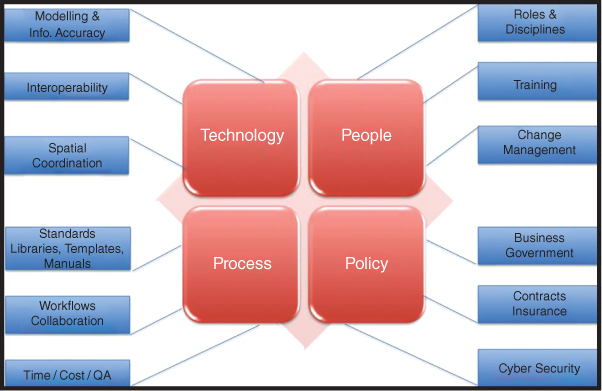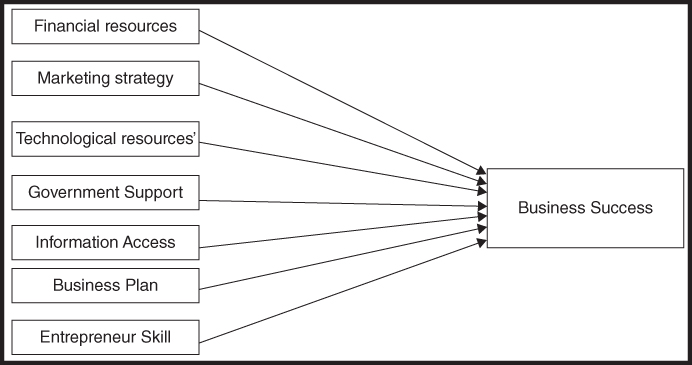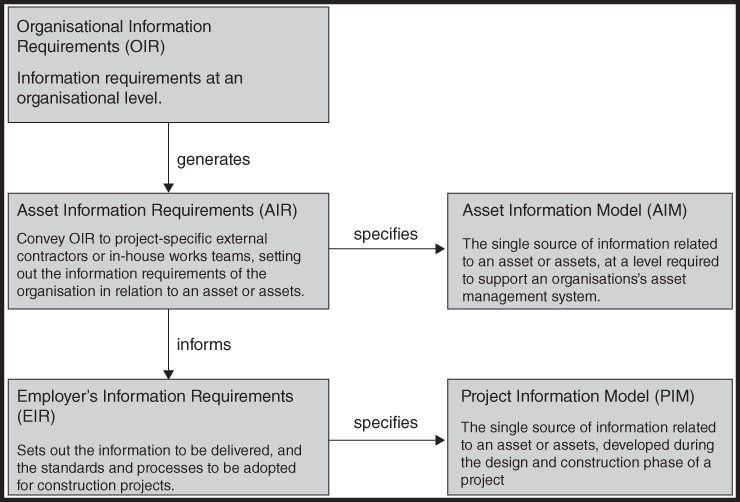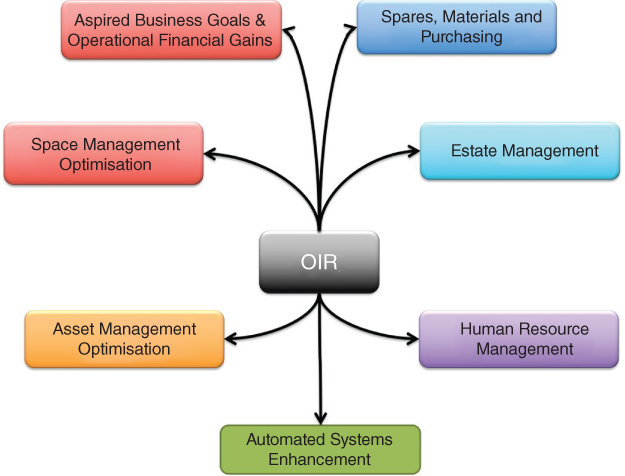22
Organisational Information Requirements for Successful BIM Implementation
Dr Noha Saleeb
Associate Professor in Creative Technologies and Construction, Design Engineering and Mathematics Department, School of Science and Technology, Middlesex University, UK
Abstract
Success of the business and its profitability is the ultimate goal for any organisation in the construction industry, whether that is achieved through return on investment (ROI), reputation, repeat business or client satisfaction. To accomplish that, an organisation must have a well‐defined business plan and objectives to implement. This chapter discusses how a successful business plan can be laid out through developing Organisational Information Requirements (OIR) in tandem with usage of Building Information Modelling (BIM) management. This will aid decision makers at corporate level to devise a business management strategy that can ensure success of running their developed assets to highest efficiency and ensure best ROI from them. This chapter hence provides a step‐by‐step process of how to create the Organisational Information Requirements documentation (OIR).
22.1 Introduction
Building Information Modelling (BIM) is a concept that has been adopted by the construction industry in an endeavour to ultimately migrate to a digital economy and hence achieve best efficiency, which would eliminate waste inherent in the industry projects and deliver best return on investment. It has been given many definitions, e.g. ‘a process for creating and managing information on a construction project across the project life cycle’ (NBS 2016). Furthermore, this chapter adopts a more holistic vision of BIM as an overarching umbrella that encompasses within it usage of more efficient processes, workflows, roles, standards, policies, and digitalisation to maximise benefit and profitability of construction or infrastructure projects via information management enabled by technology (Figure 22.1). This can include different types of management such as design, construction, project, supply chain, time, cost, risk, and quality management. Reflecting on all these components, it becomes logical that for a construction organisation to successfully manage all these on all its built assets, these categories should be embedded within the organisation‐wide long term strategic business plan in order to define what needs to be managed, the business objectives to be achieved, and key performance indicators (KPIs) to measure them, as opposed to managing each asset ad hoc individually with no overall vision for successful outputs and outcomes.

Figure 22.1 Components of building information modelling.
This merge between organisational business goals/objectives and BIM necessitates the creation of Organisational Information Requirements (OIRs), as will be explained subsequently.
22.2 Leveraging Organisational Information Requirements for Business Success
22.2.1 Business Success
It is vital to first determine the importance of thoroughly defined OIRs for the success of organisations, which is detailed below. This depends on many factors, e.g. improved business planning decreases the risks accompanying any business activity. Lack of new technology and equipment are also hindrances in development. A recent study by Jasra et al. (2011) developed and confirmed a framework for the relationship between small and medium‐size enterprise (SME) business success and its determinants. The study determined that financial resources, technological resources, government support, marketing strategies, and entrepreneurial skills have positive and substantial effects on business success (Figure 22.2).

Figure 22.2 Framework for the relationship between business success and its determinants (Jasra et al. 2011).
Another example arises where Teo and Ang (1998) demonstrate that coordinating information system (IS) plans with business plans is one of the main difficulties in IS planning. Three critical success factors determined to achieve this are:
- ISs management is knowledgeable about business
- Business goals and objectives are made known to IS management
- The corporate business plan is made available to IS management.
Furthermore, changing an organisation's focus to business objectives and the whole of life risks/rewards are of vital significance to reducing overall risk. Evaluation of risks must be founded not only on producing projects on time and within budget but also on creating and managing a long term business plan that can deliver the business objectives of the organisational stakeholders while fulfilling community expectations (Jaafari 2001).
The previous cases highlighted the importance of identifying organisational needs/requirements and business objectives for overall business success. Section 22.2.2 clarifies how this can be identified within the OIR documentation created as part of the BIM strategy for creating built assets and projects.
22.2.2 Organisational Information Requirements (OIRs)
OIRs are defined in PAS 1192‐3:2014 – Specification for information management for the operational phase of assets using BIM (BSI 2013). OIRs explain the information needed by an organisation for asset management systems and other organisational functions/needs. Hence they are organisational‐level information requirements as opposed to asset‐level or project‐level information requirements, which are created based on the OIR as per Figure 22.3. Furthermore, OIRs help inform the plain language questions asked by the client of the supply chain in the employer's information requirements (EIRs) document to achieve the project and create its BIM implementation documentation such as the BIM execution plan (BEP). The resulting outcome of this should be to achieve more efficient projects with least risk possible, successful business objectives, and return on investment.

Figure 22.3 Relationship between the elements of information management (BSI 2013).
PAS 1192‐3:2014 Annex 2 (BSI 2013) provides generic guideline activities that can aid in the creation of the OIRs; however, these require further information on how to achieve them or what to ask for as information or deliverables in the OIRs to actually accomplish that. Table 22.1 created by the author elucidates the minimal clarification categories required to include the generic guideline activities suggested in PAS1192‐3 in the OIR documentation to be able to produce the information required by the organisation.
Table 22.1 Organisation activities as per PAS1192‐3 versus required information categories for implementation in the OIR.
| Organisation activities | Information clarification required for implementation in OIR |
| Optimizing the asset management strategy |
|
| Assessing financial benefits of planned improvement activities |
|
| Modelling the asset to support operational decision making |
|
| Determining the operational and financial impact of asset unavailability or failure |
|
| Making life cycle cost comparisons of alternative capital investments |
|
| Identifying expiry of warranty periods |
|
| Determining the end of an asset's economic life, e.g. asset expenditure exceeds the associated income |
|
| Undertaking financial analysis of planned income and expenditure | |
| Determining the cost of specific activities (activity‐based costing), e.g. total cost of maintaining a specific asset system |
|
| Obtaining/calculating asset replacement values |
|
| Calculating financial and resource impact of deviating from plans on change in asset availability or performance, e.g. financial impact of deferring the maintenance of a specific generator by six months |
|
| Assessing its overall financial performance |
|
| Undertaking the ongoing identification, assessment and control of asset related risks |
|
Furthermore it can be noted that the suggested activities have no aspirational objectives or goals (except ‘optimising asset strategy’, which is generic), but merely ‘identify’/‘measure’/‘assess’/‘determine’/‘obtain’ information about certain tasks with no enhanced business outcome required as a result of them. These in their own right might be classified as ‘OIRs’ to produce, but they do not satisfy any particular business plan for the organisation, hence cannot be used to gauge the success of that business plan.
It is therefore necessary to know how to create an OIR with specific defined goals to best serve the purpose of achieving business objectives using BIM methodologies, which is explained step‐by‐step in Section 22.3.
22.3 Developing OIRs Using BIM
As demonstrated previously, it is imperative to embed the goals and objectives of the organisational strategic business plan within the OIRs and to request that information about these is delivered as a method to ensure achieving the goals. This will enable having benchmarks to track performance, reduce risks and make interim corrections during the implementation of different projects advocated as vital by Sadgrove (2016). Furthermore this will allow analysis of revenues, costs, and projected profits, and hence the organisation's strengths, weaknesses, threats, and opportunities.
Figure 22.4 displays the author's vision of the seven essential criteria that require delivery of information at organisation strategic level (i.e. OIRs). Figures 22.5 and 22.6 present subcategories of these information criteria that an organisation can create within an OIR, with Figure 22.7 providing an example of a template that can be utilised to write these information requirements.

Figure 22.4 Categories of Organisational Information Requirements.

Figure 22.5 Subcategories of organisational information requirements (1).

Figure 22.7 Example template for OIRs.
Two of the seven criteria ‘Asset Management Optimisation’ and ‘Spares, Maintenance and Purchasing’ align with the criteria in PAS 1192‐3:2014, which specify information needed by an organisation for asset management systems. However, the other five criteria feed into achieving and enhancing the success of the business plan:
- ‘Aspired Business Goals and Operational Financial gains’ – tackles information that can affect the design, construction, and operations decisions of future assets to achieve business goals.
- ‘Automated Systems Enhancement’ – deals with information related to improving smart and automated systems and procedures within future assets.
- ‘Space Management Optimisation’ – handles efficient occupancy and habitation of spaces within an asset by the users.
- ‘Estate Management’ – tackles financial partnership opportunities.
- ‘Human Resource Management’ – deals with wellbeing, development, and lifestyle of the end users.
22.3.1 Aspired Business Goals and Operational Financial Gains
As per Figure 22.5, an organisation can seek to enhance certain functionalities in their services provided in their built assets, which in turn would deliver better return on investment and profitability. An example of this is a developer who creates a series of similar type assets, e.g. supermarkets, and desires to reduce the end user's time for purchasing or checking out by 20%; airport terminals where passenger journey and check‐in times need to be reduced by 30% to reduce traffic at peak times and enhance the experience; hospitals where time to surgical wards or patient waiting times in A&E must be reduced by 50% to save patients; tube stations or office buildings or schools where the evacuation time in case of emergencies at peak times needs to be reduced to three minutes. The aforementioned examples relate to achieving time‐based business goals. Other business goals can be cost based, e.g. increase revenue from sales or food/beverages or hiring spaces by 10%; reduce cost of paying for energy consumption, heating and lighting in a building by 30%; reduce CAPEX costs by 20% by automated construction methods. All of these business goals, whether cost or time based, would have a direct impact on the design of the spaces within the assets involved and their construction methods, to achieve the goals, hence the relationship with creating AIRs and EIRs, as OIRs will dictate how the project is run and created. Ensuring this relationship will reduce the risk of failure of the business plan/venture that the organisation has in place. It must be noted that usage of metrics (e.g. 20%, etc.) provides a benchmark that the goal can be measured against (KPI), and helps designers and constructors to achieve a certain standard of quality in their work. The early coordination between these disciplines using BIM methodologies of efficient digitised information exchange, modelling, synchronous working, automated scheduling, off‐site manufacturing, visualisation, and simulation of options and alternatives will enhance this process and ensure achieving it to the highest quality possible with least risk.
22.3.2 Spares, Maintenance, and Purchasing
The subcategories of this criterion as per Figure 22.5 consider enhancing the logistics of performing maintenance by optimising stored spares and hence reducing costs. This could also be achieved by efficient analysis of suppliers and their benefits or provision of just‐in‐time supplies to reduce warehouse storage and risk of damage from faulty or long storage. Sharing resources between projects could also be a solution. All these cost and time related goals require actions to be taken during the construction phase and hence informed decision making for this phase. Again usage of BIM project management methodologies of visualised scheduling, automated cost estimation and analysis, and performing time and cost clash detection (not just design) will enhance achieving these goals and reduce the risk of organisational business plan failure.
22.3.3 Automated System Enhancement
The subcategories in this criterion, shown in Figure 22.5, require transforming construction projects to a highly digitised environment, which is enabled using BIM methodologies. To prevent corruption, loss and piracy of data, better cyber security methods should be implemented organisation wide. Improvement of data analysis, audits, exchanges, ensuring standardisation of components and information are all goals that should be aspired to, as they render processes and workflows more efficient and less prone to risk of error and hence losses and failure. These could include usage and management of smart telemetry in smart assets, big data analysis, Internet of Things, robotics, artificial intelligence, and other industry 4.0 technologies. It can be noted here that, unlike Section 22.3.1 above, no benchmark metrics are being used here due to the fact that 100% improvement in these categories (cyber security, data analysis, exchange, quality audits, etc.) are what is aspired for here.
22.3.4 Asset Management Optimisation
As per Figure 22.6, this includes enhancement of planned/preventative and reactive maintenance strategies, forecasting problems with the different asset systems, implementing the Government Soft Landings strategies to ensure better quality post‐occupancy evaluation, hence reducing overall OPEX (operational) costs. Again this can be more efficient using BIM methodologies, which use effective data analysis of the performance of the different systems to monitor and maintain them, virtual and augmented reality, e.g. for computational fluid dynamics (CFD) simulations, etc.
22.3.5 Space Management Optimisation
Operations management of an asset does not just involve maintenance of its systems; a very profitable aspect of an asset is efficient management of its spaces, e.g. distribution of lecture, class, and meeting spaces in office and educational facilities. These can be optimised not just according to numbers of occupants but also according to the function and activities of the gathering, the resources required for it, and even the characteristics of the occupants. Furthermore control of smooth movement (churn) between spaces is vital for both people and resources to transport between spaces. Again different discipline collaboration on analysis of data and visual analytics using BIM methodologies can aid this process.
22.3.6 Estate Management
This criterion looks at a broader picture, as per Figure 22.6, in terms of attracting funding opportunities, which can be public, private, using horizontal or vertical integration of organisations and their supply chains, and the benefits/drawbacks of each. These aspects can affect how a project is implemented and an asset built, hence requiring thinking of suitable procurement types, e.g. more collaborative integrated project delivery or insurance (IPD/IPI) routes, which will ultimately change how a project is managed and the BIM methods/tools/procedures/roles required to facilitate that. Other factors included in this criterion are enhancing logistics and waste management processes.
22.3.7 Human Resource Management
This final criterion is probably the most unusual to include in a business plan and require information for. However, considering that the ultimate goal of any business is repeat business, which can only be achieved by customer loyalty and satisfaction, it becomes apparent that having goals related to end user wellbeing and satisfaction is crucial. Factors for the organisation employees include providing training, continuous professional development (CPD), placement opportunities, and knowledge transfer. Factors for the asset users include enhancing their experience within the spaces to achieve higher quality experience and improved morale, which can be achieved by improving the design of the asset. This engagement between supplier and end user is part of the BIM collaboration process, and helps reduce the risk of failed projects.
22.3.8 OIR Template
Upon identifying all the criteria and subcategories of information that can be included in an OIR, it is imperative to find an understandable way to translate this into document form. Figure 22.7 gives an example of a chart template that can be used to populate OIRs. It starts with identifying the subcategory at hand in the first field, followed by standard information of organisation name/ID/owner. The next field could show who, or which roles, is responsible for handling or decision making or providing the information on a particular issue, and who is financially responsible for it (could be the same or different personnel). It could then be important to write the plain language question(s) that the organisation should ask to ensure achieving an issue, followed by acceptance criteria for it. These can include KPIs, standards, benchmarks, methods, procedures and workflows, and even tolerances and levels of detail and information to be provided. It is also important to provide links for any necessary external documentation related to an issue. The start date and completion date are optional fields in case this OIR is specific to a particular project only and not a long term business plan. Extra fields could be added to show the type of project, specific characteristics related to it, etc. One beneficial field could be to indicate the current level of objective completion of a particular factor, e.g. current evacuation time. This could be useful to show what needs to be done to reach the new objective metric, e.g. three minutes, 20% enhancement, etc.
Ultimately, the way an OIR document is expressed can be in any format that the organisation sees as being most viable and efficient to express its needs.
22.4 Conclusion
This chapter discussed the importance of aligning an organisation's strategic business plan with its information requirements to achieve its business goals and objectives successfully. Furthermore, a step‐by‐step guide for how to create information criteria and subcriteria was recommended to populate an OIR chart and ask for relevant information using the methodologies of BIM. This enables executive decision makers to create a strategy that can inform the creation of Asset and Employer Information Requirements documentation (AIRs and EIRs) for individual projects, and influence design, construction and operation decisions during their respective phases to achieve the overall business goals successfully.

Figure 22.6 Sub‐categories of organisational information requirements (2).
References
- BSI (2013). PAS 1192:2 2013 ‐ Specification for Information Management for the Capital/Delivery Phase of Construction Projects Using Building Information Modelling. London: BSI.
- Jaafari, A. (2001). Management of risks, uncertainties and opportunities on projects: time for a fundamental shift. International Journal of Project Management 19 (2): 89–101.
- Jasra, J.M., Hunjra, A.I., Rehman, A.U. et al. (2011). Determinants of business success of small and medium enterprises. International Journal of Business and Social Science 2 (20): 274–280.
- NBS. (2016). What is Building Information Modelling (BIM)? Available at: https://www.thenbs.com/knowledge/what‐is‐building‐information‐modelling‐bim. (Last accessed 13 May 2018).
- Sadgrove, K. (2016). The Complete Guide to Business Risk Management. Routledge.
- Teo, T.S.H. and Ang, J.S.K. (1998). Critical Success Factors in the Alignment of IS Plans with Business Plans. Faculty of Business Administration, National University of Singapore.